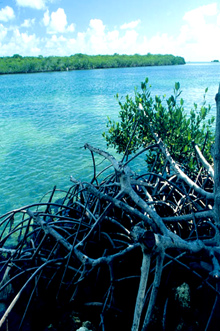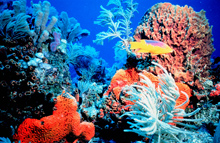Fisheries Management:
Building a Sustainable Future for America's Fisheries
Fisheries management is the effort to regulate where, when, and how people fish—protecting fish populations so that people can continue to fish in the future. NOAA's National Marine Fisheries Service is the federal agency responsible for the management, conservation, and protection of our nation's fishery resources. Through fisheries management, NOAA works to ensure that marine resources continue as functioning components of marine ecosystems, afford economic opportunities, and enhance the quality of life for the American public.

America's insatiable demand for quality seafood supports thousands of premium markets around the country, like this one in Seattle. Click image for larger view.
A fresh shrimp dinner. A tuna fish sandwich for lunch. A trip to the sushi bar. Many of us enjoy fresh seafood on a regular basis today, but how do we ensure that future generations are able to enjoy the same tasty meals 10 or 20 years from now? Part of the answer lies in fisheries management.
For 135 years, NOAA and its predecessor agencies have had a role in managing our nation’s fisheries. As NOAA looks to the future, the agency is embracing an “ecosystem-based” approach to fisheries management. An ecosystem approach is one that considers all living resources within a marine area, all sources of environmental stress, and all factors influencing the ecosystem in making management decisions. In 2027, 20 years from today, it is this broad, holistic view that will guide NOAA fisheries management.
Defining an Ecosystem-based Vision
Through effective stewardship of living marine resources, NOAA can promote a sustainable future for America’s fisheries. To say a fishery is sustainable means that it can provide for today’s needs without damaging the ability of future generations to provide for themselves. Sustainable practices can be carried out repeatedly, without high economic or environmental costs.

Sustaining stocks of reef species, such as these gray snappers, requires an ecosystem approach to management. Click image for larger view.
For several years, fisheries scientists and managers have advocated ecosystem approaches to fisheries management. Under this approach, management programs consciously account for and address all living resources within a specific marine area or ecosystem, including stocks targeted by fishing operations, non-target stocks, and the marine environment. This differs from traditional management approaches that tend to manage one issue or resource in isolation, without considering impacts or factors from other ecosystem components. An important aspect of an ecosystem approach is balancing the needs of the environment with the economic, social, and recreational needs of the people who use the environment. Such an approach involves making decisions using a comprehensive, inclusive framework for all living resources, rather than reacting to the status of a single stock of fish.

The 1990s saw NOAA Fisheries expanding its authority to protect many fisheries habitats, such as mangroves. Click image for larger view.
NOAA has already embraced this ecosystem-based approach to fisheries management and will continue to do so in the future. Rather than focusing on specific species or geographic areas, future planners will examine impacts throughout an ecosystem. NOAA will make water, land, and resource management decisions that maintain local and state authorities and are flexible enough to address local conditions.
Proposed policies will encourage innovation and use economic incentives—rather than mandates—as much as possible. Ecosystem-based management will establish strong partnerships between federal, state, tribal, and local governments; the private sector; international partners; and other interests. Local involvement and partnerships will continue to be essential in managing and protecting ocean, coastal, and Great Lakes resources.
Implementing the Fisheries Management Vision
NOAA has already begun implementing an ecosystem-based approach to fisheries management and the agency will continue to make strides to better manage our nation's fisheries in the future. Some mechanisms that NOAA is using and which will evolve to help NOAA manage fisheries 20 years from today are outlined below.
Magnuson-Stevens Fishery Conservation and Management Act (MSA)

Modern resource management includes partnerships with many players, including Native Americans, such as this Tupik salmon fisherman in Alaska.
One of the key tools NOAA will use to reach its vision of comprehensive fisheries management is the reauthorization of the Magnuson-Stevens Fishery Conservation and Management Act (MSA).
Originally enacted in 1976, the MSA is the primary law governing marine fisheries management in the federal waters of the United States. Congress passed the MSA to conserve and manage U.S. fishery resources, develop domestic fisheries, and phase out foreign fishing activities within the 200-mile zone adjacent to the U.S. coastline (an area known as the Exclusive Economic Zone or EEZ). The MSA also established eight regional fishery management councils, each of which are responsible for developing fishery management plans and planning amendments to regulate marine fisheries in federal waters.
In 1996, the MSA was amended. Amendments strengthened conservation through requirements to constrain fishing based on the biology of fish species; rebuild overfished populations; protect ocean habitats essential to fishes throughout their lifecycles; and minimize the deaths of fish, birds, and other wildlife that are incidentally caught during fishing operations.
As NOAA moves ahead, the MSA will likely be changed in response to shifting societal needs and interests, as well as a better understanding of ecosystem management. Such changes will help to promote the long-term health of U.S. marine resources, building upon successes of the MSA and evolving to meet modern needs and scientific understanding. These changes might include increasing the information used to rebuild declining fish populations, strengthening fisheries enforcement, or promoting the use of market-based management tools.
Rebuilding Fish Populations

NOAA's habitat restoration projects are focused on returning damaged shoreline areas, such as this one in Massachusetts, to productive fisheries habitat. Click image for larger view.
Rebuilding declining fish populations is an important element in ensuring that future generations will have access to the same fish that we have today. Rebuilding stocks will require an end to overfishing and the incorporation of fish life history characteristics, such as reproductive rate and lifespan, into rebuilding plans. Expanding data collection and the types of tools for collecting data will provide NOAA with the best and most accurate information needed to make management decisions. By establishing a scientific review process and national data collection program, NOAA can ensure the quality and consistency of fisheries data.
Strengthening Fisheries Enforcement
NOAA Fisheries Office for Law Enforcement enforces laws that protect and regulate our nation’s living marine resources and their natural habitats. Today, NOAA Fisheries’ special agents and enforcement officers enforce over 37 statutes, as well as numerous treaties related to the conservation and protection of marine resources.
Twenty years from today, law enforcement will continue to play an important role in protecting delicate marine resources. Strengthening existing fisheries enforcement legislation, such as the MSA, with increased civil and criminal penalties for violators will help to deter repeat offenders.
Market-based Management
Research suggests that many commercial fisheries would benefit from a market-based system of management. NOAA will continue to explore these market-based approaches. Such approaches use economic incentives to protect fisheries, as opposed to conventional methods that rely on policies such as gear restrictions and seasonal limits to manage fisheries. Such a system would maximize yield while empowering fishing communities to control their own financial destiny.

By the 1980s, NOAA Fisheries gear specialists had developed a cost-effective Turtle Excluder Device for trawl nets. Click image for larger view.
One example of a market-based management system is the use of dedicated access privilege programs, such as individual fishing quotas, or IFQs. IFQs are management programs that provide individual fishermen an exclusive, market-based share of the annual harvest quota. If a fisherman wants more quota than he received through initial quota allocations, he can purchase additional “shares.” On the other hand, a fisherman who has more quota than he needed can sell his “shares” and invest his money elsewhere. In this way, a market develops where quota shares are bought and sold. This system allows quota shares to move to the most efficient fishermen because they value them most highly and are willing to pay the highest price for them. It also provides fishermen the opportunity to sell out and leave the fishery when productivity is low—a change from the present system, which encourages fishermen to stay in the business even when profits are very low because they have no other options.
Investment in Research
Enhanced ecosystem approaches to management will require a strong investment in scientific research. We do not yet know enough about all of the impacts we have on the oceans under our management. Better science will yield better management strategies. NOAA will seek enhanced collaboration, coordination, and cooperation in researching fisheries and will identify gaps and deficiencies and related infrastructure needed to better understand how fishing impacts the ecosystem in which it occurs.
International Participation

The immense value of tunas, like this giant ensnared off Spain, require international cooperation if their populations are to be sustained. Click image for larger view and image credit.
Although the U.S. enjoys the largest EEZ in the world, our nation is affected by other fishing nations’ activities on the world’s oceans. As a matter of national and economic security and international leadership, the U.S. follows the U.N. Convention on the Law of the Sea. This law establishes claims of territorial waters and universal legal controls for the management of marine natural resources and the control of pollution. The U.S. also participates in international organizations that manage high-seas harvests, such as the International Whaling Commission and International Commission for the Conservation of Atlantic Tunas. Such participation will continue to be important in our increasingly globalized world.
Looking Ahead…

New challenges for fisheries management arise from concern over the decline of America's coral reefs. Click image for larger view.
The plans, programs, and legislation discussed above provide a snapshot of what NOAA is currently supporting and what the future holds for fisheries management. Working together with the American people, NOAA will protect our fisheries resources through wise stewardship decisions and support for rebuilding of stocks through science-based conservation and resource management. Our vision of success will be the American public enjoying the riches and benefits of sustainable, healthy, and diverse marine ecosystems, while preserving the fishing heritage that has contributed so much to the growth and history of this nation.
